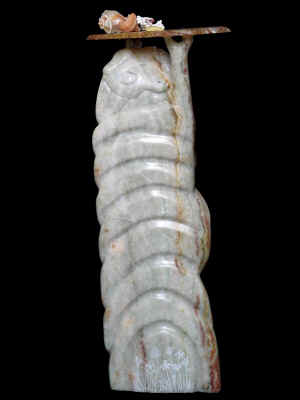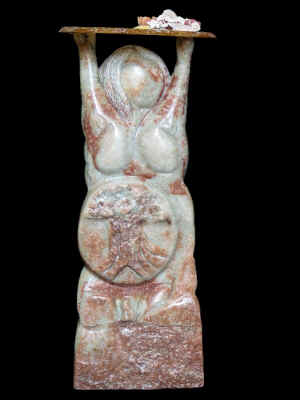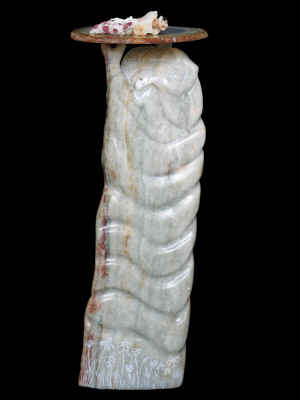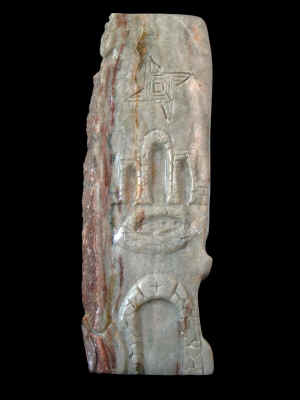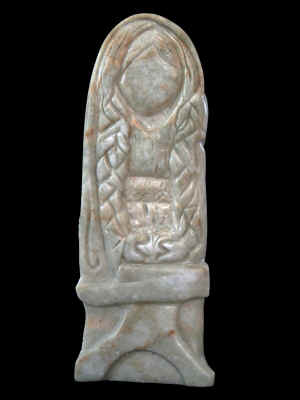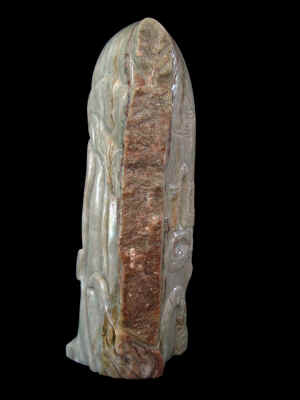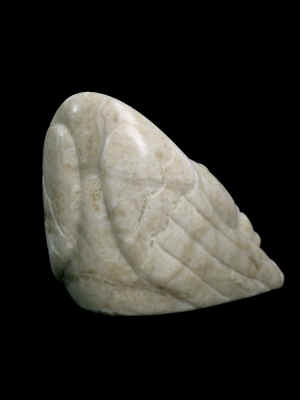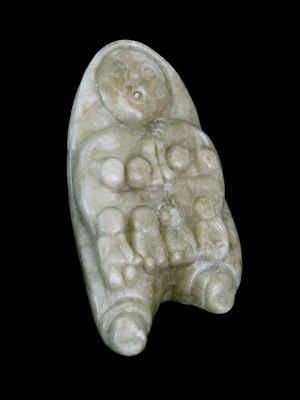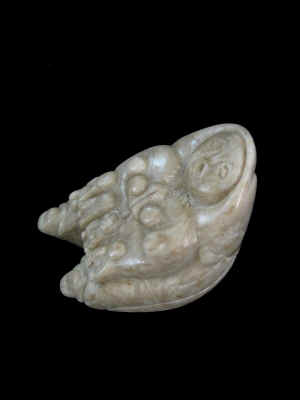|
IXCHEL
Ixchel is a Mayan Moon Goddess. She is recognized as
a rain goddess as well. She was full of life force energy and always wet
with love. From her skirt rainbows trailed and all of the plant
medicines were berthed. She is known as the Goddess of fertility,
flowering and pleasure. Ixchel is associated with medicine and midwives. The moon is representational of womyn's cycles and fertility. She
is often depicted holding an upside down jar representing a stop in the
flow of blood associated with pregnancy and the crone. She often has
claws instead of hands. Cozumel is the
Island
where people make pilgrimages in her honor.
My
experience while sculpting this piece was the surprise of finding the
symbols coming forward. The Condor on the backside appeared after taking
one swipe with my Makita grinder. It was the perfect symbol for the
Mayan culture and part of my commitment to the Eagle and Condor
Prophecy. The moonscape at the bottom represents her connection to the
phases of the moon. Her belly is pregnant with the Tree Of Life. Several
triangles representing the triple Goddess presented themselves in the
piece. The rainbow on the backside depicts the meaning of her name, the
seven chakras, and the flowers represent the birthing of all the diverse
plants that emerged from her skirt. As a healer, I am drawn to her as
the mother of all plant medicines. I am also called by her passion for
life and her willingness to allow herself the pleasures of Earth. |
|
BRIDGID
Bridgid, also spelled Brigit,
Bridget, Bridgit, Bríd or Bride is a bridge between the Pagan and the Christian
world. Raised by Druids and seen as a Goddess, she was also recognized
as a Saint. In this way she managed to keep the veneration of womyn
alive despite patriarchy. She is the muse of Smithing, artisans and
poets. Her feast day is the day of her death, February 1st and is
recognized as Imbolc or Candlemas. It marks the return of light.
The legend of Bridgid's
mantle explains her procurement of land for the convent she built at
Croghan Hill. The king denied her the land she had requested which had a
huge oak tree at the top of the hill. Years later, after hearing about
all of the miracles she had performed, he asked her to heal his
cauliflower ear. He had hidden this deformity because it was considered
a sign that he was not chosen to rule. After healing his ear he agreed
to giver her the land, but he told her that she could have only as much
land as her mantle (cloak) would cover. The day they went to claim the
land four assistants took the edges of her mantle and began walking
backward in the four directions. When they were finished her garment
covered the entire hillside.
The symbols etched into this
piece tell the story of her many sides. The anvil depicts her connection
with the arts and the oak leaf in her hands reflects her Druid roots.
Her staff is hidden upside down in her mantle. Bridgid's cross is
featured in the side above the well of Kildare. Her angel wings depict
her status as a saint. The candle on the back represents the flame
keepers of Kildare. The fire at Kildare was put out during the
fourteenth Century. In the 1970's a group of feisty feminist nuns re-lit
the fire. Keepers of the flame are in covenants of 19 and hold prayer
vigils. In this way the flame is always kept burning. Tapers lit from
the fire of Kildare are passed to the new members in order to light
their candles and keep the original flame burning in their hearts.
When you sit in contemplation
with this piece it brings inspiration for creativity. The fiery passion
of Bridgid ignites our desire to be of service to others with
compassion. Expect miracles that come from kindness to flourish in your
life while working with her. |
|
SINGING
MOTHER
This Singing Mother angel comes to honor your gift as
the keeper of your family story. The men are the story tellers of the
Pueblo people, so the female figures are more aptly known as the
"Singing Mother". In 400 AD, these figurines, usually in human
female form, were an integral part of the Anasazi culture.
The first contemporary storyteller doll was made by
Helen Cordero of the Cochiti Pueblo in 1964 in honor of her grandfather
who was a tribal storyteller. Helen was born in 1915 and grew up
listening to the oral history of her people. Wisdom, she believed, came
into the world, not because it was spoken, but because it was heard. A
beautiful Pueblo woman I know once shared with me that "our words
are the food that our children eat. Are they nourishing and can they be
savored?" Today the term "storyteller" is a generic term
and is used to describe any figure, (female, clown, animal, male,
spirit) that is covered by children or baby animals. |
|
PELÉ
Described as Pele-honua-mea,
"She-Who-Shapes-The-Sacred-Land" in ancient Hawaiian chants, or
the Goddess of a Thousand Names, She is also known as Ka-'ula-o-ke-ahi,
which means the redness of the fire. The Hawaiian word pelé means
molten lava. Her people say, when Pelé was young the center of the
earth glowed with her loveliness, and she was content for a million
years to live in Her house in the center. Pelé claims that all acts of
pleasure and joy are Hers, including sexuality.
Pelé, is passionate, volatile, and capricious.
Dwelling in the craters of the Big Island's Kilauea Volcano, Pelé is a
destructive goddess who can make the earth quake with a stamp of her
feet. Easily insulted, the ill-tempered goddess can throw fiery tantrums
to start an eruption, and in response to fervent prayers from her
subjects she can as abruptly stop the flow of lava. No human sacrifices
were ever made to Pelé, just red Ohelo berries in ancient times and gin
or brandy in later days. There are many stories equating Pelé's wrath,
usually stimulated by jealousy or someone's arrogance, to volcanic
eruptions or destructive lava flows. She has been sending ribbons of
fiery lava down the mountainside almost continuously since 1983 adding
70 acres of new land around the southeastern shore. Over one hundred
structures have been consumed by her.
In modern times, Pelé has become the most visible of
all the old gods and goddesses. Many people have reported a red-robed
woman dancing on the rims of the fiery mountains. Pelé, a shamanic
shape shifter, continues to show herself to people in the form of a
beautiful maiden or an old crone wearing white traveling with a white
dog and begging for kindness. Truckers report picking up a hitch hiker
of that description who
suddenly disappears, but not without giving them blessings. She brings
bad luck to those who are greedy or rude to her. |
